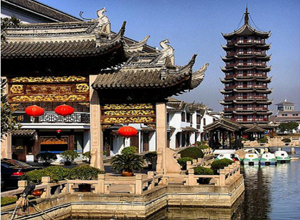
Zhouzhuang (Chinese: 周庄) is a water town in Jiangsu Porvince, China, about 30 km southeast of Suzhou and 60 km west of Shanghai. It is a popular tourist destination, classified as a AAAAA scenic area by the China National Tourism Administration. It is usually sightseed together with Suzhou as 1 day excursion tour from Shanghai.
Zhouzhuang is one of the most famous water townships in China, noted for its profound cultural background, the well preserved ancient residential houses and the elegant watery views. The town’s history could be traced back to the Spring and Autumn Period (770BC-476 BC). Many historical sites remains. The most important are the Twin Bridges, Fuan Bridge, Shen House, Zhang House, Milou Tower, and Chengxu Taoist Temple. The Shen House was the private property of the descendant of Shen Wansan, the richest man of Jiangshan in the early Ming Dynasty. The most famous and delicious local food Wansan pork hock, is named after Shen Wansan.
Travelers in Shanghai can reach Zhouzhuang by taking bus from Shanghai South Long Distance Bus Station located near Shanghai South Railway Station.
Admission: 100RMB
Boat ride: 40RMB per head/100RMB per boat
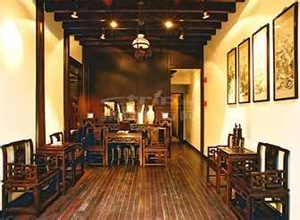
Wulixiang Shikumen Museum, Shanghai
Wulixiang Shikumen Musuem (Chinese: 屋里厢博物馆) is located No 25, Lane 181 Taicang Road, in Xintiandi of Shanghai. It is a themed exhibition hall that displays the traditonal Shanghai residental houses called Shikumen. “Wulixiang” literally means “home” in the Shanghai dialect. Over 70% of Shanghai residents were born and raised in Shikumen houses. However, Shikumen are now fast disapearing; downtown, only areas like Tianzifang and Xintiandi remain some.
The Exhibition Hall is in a renovated Shikumen house built in the 1920s. It covers a floor space of 367.2 square metres and a gross floor area of 513.9 square metres. It is modlled on a household in an alley. There are seven exhibition rooms: the sitting room, the study room, the elderly room, the master bedroom, the daughter’s room, the son’s room and the kitchen. It reapears how a typical family lived in Shanghai in the 1920s. All the articles on display, whether cooking ranges or children’s textbooks, lipsticks or ashtrays, are all genuine 1920s or 1930s things sourced in the Shikumen alleys.
The museum is near the site of the First National Congress of the Communist Party of China.
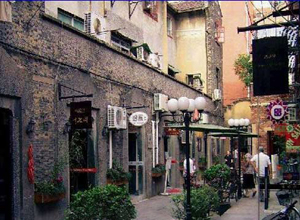
Tianzifang, Shanghai
Tian Zi Fang (Chinese: 田子坊) is located in the former French Concession area of Shanghai. The district is also referred to as Taikang Road or Taikang Lu, which is a little off the area.Tian Zi Fang is an art enclave that has developed from a renovated residential area. The area is known for small craft stores, coffee shops, trendy art studios and narrow alleys. It has become a popular tourist destination in Shanghai. Often compared with Xian Tian Di of its same kind, Tian Zi Fang has better preserved the local Shikumen buildings and gives more artistic atmosphere.
The neighborhood was originally built in the 1930s. The houses were traditional local Shanghai residential buildings called ‘shikumen’, literally ‘stone doors’, which were built with stone doorframes and solid wooden doors, hence the name.
Tianzifang enclave has expanded from Lane 210 to Lane 248. The entrance of Tian Zi Fang is Lane 210, Taikang Road. It is a nest for art and design studios, crafts shops and galleries, antique shops and some boutiques, etc. Many are operated by international owners.
Tian Zi Fang is near Shanghai Metro Dapuqiao Station, Line 9.
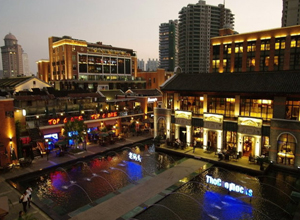
Xintiandi, Shanghai
Xintiandi (Chinese: 新天地) is an affluent car-free shopping, eating and entertainment district of Shanghai. It is considered one of the upscale lifestyle centers in China. The highlight is the reconstituted traditional mid-19th century local shikumen houses which now serve as shops, cafes, restaruants, books stores, and shopping malls. Here is also one of the most active nightlife site in the city.
Xintiandi is located in the city center of Shanghai south of Huaihai Zhong Lu (Huaihai Middle Road). The neighors include the the first congress of the Communist Party of China, Shikumen Open House Museum and the site of the Provisional Government of the Republic of Korea.
Two kilometers away, there is a place of the same kind, called Tianzifang, which is also a art street.
By Shanghai metro system, you shall get off at South Huangpi Road Station, Line 1, or Xintiandi Station, Line 10.
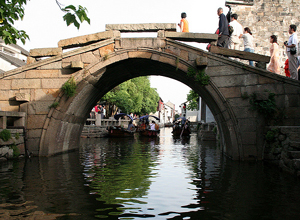
Zhujiajiao (Chinese: 朱家角) is an ancient water town located in the Qingpu District of Shanghai. The beautiful scenery has won it the reputation as ‘oriental Venice’. It was established about 1,700 years ago and is the best-preserved among the ancient towns in Shanghai. The town boasts 36 old stone bridges, numerous small rivers an streams shaded by willow trees, and traditional courtyard houses. Zhujiajiao has become a popular excursion place when touring Shanghai.
The town prospered through clothing and rice business. Many hsitoric sites remains, such as rice shops, banks, spice stores and even a Qing dynasty post office. The main sites are Fangsheng Bridge, North Street, Kezhi Garden, and Yuanjin Buddhist Temple.
The local cuisine is worthy a try, particularly green soy beans, zarou, and lotus roots.
The town could be reached by taking tourism bus at Shanghai Stadium (Gate 5).
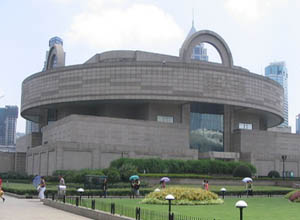
Shanghai Museum
Shanghai Museum (Chinese: 上海博物馆) is another popular attraction located on the People’s Square in the center of Shanghai. It is a large first-rate museum that focuses on ancient Chinese art.
The building is 9.5 meters high with five floors, covering a total area of 39,200 m² . It is designed in the shape of an ancient bronze cooking vessel called a ding. It has a round top and a square base, symbolizing the ancient Chinese perception of the world as ‘ round sky, square earth’. The museum has 11 permanent galleries and 3 special temporary exhibition halls, with a collection of over 120,000 pieces, including calligraphy, paintings, bronze, ceramics, jades, furniture, sculptures, ancient coins, seals, minority art and foreign art. Some are national treassure , including one of the three extant specimens of a “transparent” bronze mirror from the Han Dynasty. In the gallery of Ancient Conis, it is worthy to see the ancient coins from the Silk Road. The collection contains 1783 pieces form the Greeks to the Mogol Empire.
Admission: FREE
Opening Hours: 09:00-17:00
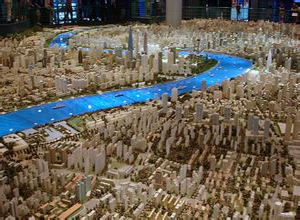
Shanghai Urban Planning Exhibition Center (Chinese: 上海城市规划展示馆) is located on People’s Square, the city center of Shanghai. It is one of the most popular tourist attractions of People’s Square. The centerpiece exhibition is a highlight. It is a huge scale model of the city of Shanghai, showing all its existing buildings and streets downtown.
Shanghai Urban Planning Exhibition Center was open to the public in 2000. Themed on “City, Citizens, Environment, and Development”, the Center displays the past, present and future of Shanghai by traditional and modern displaying means. It is regarded as the “Window of the City” where people can better learn about Shanghai. The huge scale model of the city of Shanghai displays every building and corner of downtown Shanghai. Visitors can view the model from alongside or ascend to a gallery running around it for views from above. The center not only shows the latest information of urban development, but also shows Shanghai citizens’ cultural and artistic cultivation. Over 100 such exhibitions have been held in the second floor exhibition hall.
There is also a small demonstration hall housing a 360° screen. The room plays a video that guides you to the main Shanghai attractions in a vivid way.
Admission: 30 RMB
Opening Hours: 09:00-17:00
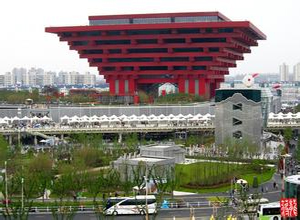
Expo 2010, Shanghai
Expo 2010 was held in Shanghai from May 1 to Oct 31, 2010. It is the 41st World Expo in the tradition of international fairs and expositions, the first since 1851 in London. The theme of Expo 2010 was “Better City – Better Life” and signifies Shanghai’s new status in the 21st century as the “next great world city”. Covering 5.28 square km and containing over 70 exposition pavillions, Shanghai Expo was the largest World’s fair site ever. It also boasts the largest number of countries and people participating. By the end of the expo, over 73 million people had visited and 246 countries and international organizations had participated. On 16 October 2010, the expo set a single-day record of over 1.03 million visitors.
There were five central theme pavilions at the Expo 2010 – Urban Footprint, Urban Planet, Urbanian, City Being, and Urban Future – each exploring different aspects of urban development. 189 of the world’s 196 nations were represented at Expo 2010, either in stand-alone pavilions or within larger pavilions. The three largest national pavilions were the China Pavilion, the Africa Pavilion, and the Pacific Pavilion. The pavillion of United Kingdom won the title of Best Pavilion at the Expo for its novel design like Dandelion.
After the fair finished, most of the pavillions were dismantled. However, the China pavilion along with the theme pavilions, Expo Cultural Center and the Expo Axis wer remained. On 1 October 2012, the China pavilion was reopened as the China Art Museum. There are a few other national pavillions still open, such as Saudi Arabia’s and Italia’s.
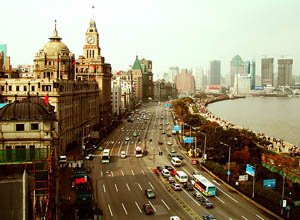
The Bund (Chinese:外滩) is a waterfront area by the west side of Huangpu River in central Shanghai and regarded as the symbol of Shanghai for hundreds of years. Traditionally, the Bund begins at Yan’an Road (formerly Edward VII Avenue) in the south and ends at Waibaidu Bridge in the north from the Waibaidu Bridge to Nanpu Bridge and winds 1500 meters in length. As the former Shanghai International Settlement, it features 52 colonial buildings of different architectural styles including Gothic, Baroque, Romanesque, Classicism and the Renaissance, offering quite impressive scenery along the Bund and Huangpu River.
Besides the architecture and buildings, the Bund features several sculptures. Near the Nanjing Road intersection stands a statue of Chen Yi, the first Communist mayor of Shanghai. It is currently the only bronze statue along the Bund. At the northern end of The Bund, along the riverfront, is Huangpu Park, in which is situated the Monument to the People’s Heroes – a tall, abstract concrete tower which is a memorial for those who died during the revolutionary struggle of Shanghai dating back to the First Opium War. The other outstanding sculptures include the Ever Victorious Army Momument funded by Li Hongzhang, a late Qing Dynasty officer; the Statue of Hart, who had served as Secretary General of Chinese Customs up to 48 years; and the World War Monument, made to commemorate the soldiers who died in the World War I coming from Shanghai.
The night visit of the Bund is stongly suggested. It fully exhibits the magnificence of the classic buildings with the lighting system and make up of the best night scene of Shanghai together with the colorful lights floating in the river and flashing Pudong sights opposite. The Bund is also heaven for nightlife with a multi choice of restaurants, bars and clubs.
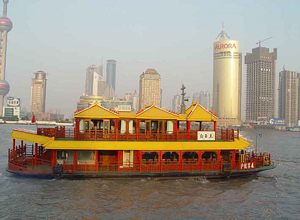
Huangpu River Cruise
Huangpu River (Chinese: 黄浦江) is symbol of Shanghai ctiy. It is ice-free year round and is the city’s shipping artery both to the East China Sea and to the mouth of the Yangzi River, which the Huangpu joins 29km north of downtown Shanghai at Wusongkou. It has also become a demarcating line between two Shanghais, east and west, past and future. On its western shore, referred to Puxi, are the clonial landmarks of the Bund; on the eastern shore, or Pudong, are the modern skyscrapers like Oriental Pearl TV Tower, Shanghai World Financial Centre and Jin Mao Tower. The river witness Shanghai’s history and development.
A Huangpu River cruise is the best way to appreicate the scenery along the river. The usual cruise takes 1 hour. It plies the main waterfront area between the two suspension bridges-Nanpu Bridge in the south, and Yangpu Bridge in the north, appearing to arch over the Oriental Pearl TV Tower, resembling ‘Two dragons playing with a ball’.Cruising on Huang River at night is highly recommended with the lit brilliantly skyline of Pudong rife with skyscrapes and the lit Bund with beautiful colonial buildings. Full 3-hour afternoon cruise is also available, to Wusongkou and back. Boats depart from the Shiliupu Wharf, just south of the Bund, No. 171 Zhongshan Nan Lu. Take the subway line 2 and get off at Nanjing Dong Lu (Nanjing East Road), then walk along the Bund to the Shiliupu Wharf. You could also choose to take bus 33, 55, 65, 305, 868, 910, 928 and get off at the bus stop of Shiliupu.
There is also a quick 40-min Huangpu cruise picked up on the Pudong side of the river. Tickets can be purchased at the Oriental Pearl TV Tower ticket booth.
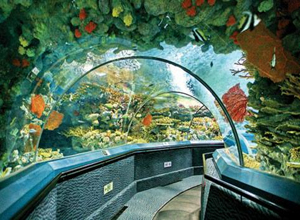
Shanghai Ocean Aquarium (SOA; Chinese: 上海海洋水族馆) is the biggest aquarium in Shanghai and one of the most beautiful ones in the world. It features a 120-meter tunnel that takes visitors through a coastal reef, open ocean, a kelp cave, shark cove, and a coral reef, and is one of the longest such tunnels in the world. It is located just next to the Oriental Pearl Tower in Shanghai’s Lujiazui Financial & Trade Zone of Pudong District.
SOA is divided into 9 different thematic zones, with a collection of more than 450 species of aquatic animals from the five continents and four oceans. The zones are divided by regions. It begins from the Yangtze River in China, then on to the mysterious flooded forest of the Amazon in South America, next, the mangroves and billabongs of Australia, then the rivers of Africa before arriving at the rainforests of Southeast Asia. Brave the cold as you go through the icy waters of the Antarctic.The last leg takes you from the sandy shores to the depths of the ocean. The main highlights from these various zones include the Chinese sturgeon, Giant Salamander, Electric Eels, Spotted seals, Weedy Seadragons, Jellyfish, Sand Tiger Sharks, and many more.
Admission: 160 RMB
Opening Hours: 09:00-18:00
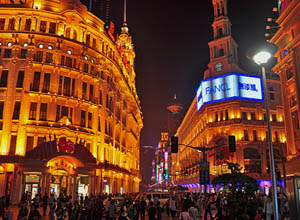
Nanjing Road, Shanghai
Nanjing Road (Chinese: 南京路) is the main shopping street of Shanghai. Today’s Nanjing Road comprises two sections, Nanjing Road East from the Bund to People’s Square and Nanjing Road West from People’s Square towards the junction of Jing’an Temple and Yan’an Street. Commonly, Nanjing Road refers only to Nanjing Road East, which is largely pedestrianised. The road has become one of the world’s busiest shopping streets, attracting over 1 million visitors daily.
Nanjjing Road is about 6 km long, the world’s longest shopping distict. The eastern section features pedestrian mall with Shanghai’s largest department stores, domestic retail outlets, time-honored traditional eateries, Peace Hotel, and Central Maket, a century-old outdoor market today specialising in electronic components and digital media. The western section is now host to upscale shopping centers, restaurants, prime office buildings, Shanghai Exhibition Centre and several Shanghai’s pestigious historic hotels, including Park Hotel.
Nanjing Road is served by the Shanghai Metro Line 2, by the main stations of Nanjing Road (E.), People’s Square, Nanjing Road (W.), and Jing’an Temple, from east to west.
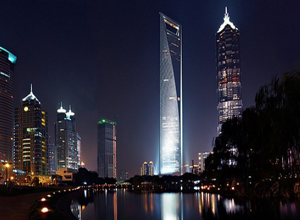
The Jin Mao Tower (Chinese: 金茂大厦), literally ‘Golden Prosperity Building’, is an 88-storey skyscraper in the Lujiazui area of Pudong District of Shanghai. With a height of 420.5 meters, it is the 2nd talllest in mainland China; the first is the Shanghai World Fianncial Center (492 m) which is next to the building. However, they will soon be surpassed by another neighbor-Shanghai Tower, which is still under construction and is to reach 128 storeys.
Jinmao Tower is a perfect combination of traditional Chinese architectural style and the world’s modern architectural technology. The building has 3 main entrances to the lobby, two for the office portion and one for the the Grand Hyatt Hotel, which occupies floors 53 to 87 and one of the highest in the world. The Hyatt is famous for its barrel-vaulted atrium starting at the 56th floor and extends upwards to the 87th, quite elegent and impressive. On the 88th floor, it is the observation deck, a 1,520 m2 indoor observation deck with a capacity of 1,000+ people. In addition to the panoramic views of Shanghai, it offers a topside view of the hotel atrium below.
Jin Mao Tower is accessible from Lujiazui metro station, Line 2.
Admission Fee: 120 RMB
Opening Hours: 08:30-21:30
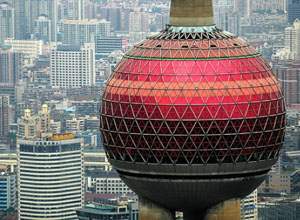
The Oriental Pearl TV Tower, Shanghai
The Oriental Pearl TV Tower (Chinese: 东方明珠塔) is located at the tip of Lujiazui in the Pudong district by the side of Huangpu River, opposite The Bund across the river. It is a distinct landmark in the area. At 468 m high, it was the tallest structure in China when completed in 1994 (the tallest now is Shanghai World Financial Centre). Currently it is the sixth tallest TV Tower in the world. The tower is classified as a AAAAA scenic area by the China National Tourism Bureau. It is a popular Shanghai attraction to have a bird’s view of the city.
Besides its height, the tower is outstanding for its unique design. It features 11 spheres, big and small. They are linked by three columns, each 9 m in diameter. The two largest spheres have diameters of 50 m for the lower and 45 m for the upper. The highest sphere is 14 m in diameter. The entire tower is supported by three enormous columns that start underground.
The inner tower is a comprehensive recreational place. The Shanghai History Museum, located in the tower’s base (0 M), holds a interesting multimedia exhibition, presenting from the beginning to the modern day of Shanghai. There are 15 observatory decks. The outdoor Transparent Observatory (259 M) uses all glass panels, making you feel like strolling in mid air, providing 360° full views. The Sightseeing Floor (263 M) is the main observatory deck for a panorama of the city. The Revolving Restaurant (267 M) is where you can having romantic meal while appreciating the city in 360 degree. The highest Space Module (350 M) at the top sphere is fantastic place which simulates the universe with high technologies, providing many interesting interactive activities. There is also a 20-room hotel called the Space Hotel, located in the five smaller spheres between the two biggest ones. Moreover, the tower is equipped with souvenir shops and leisure bars. It also operates Yangtze River boat cruises.
Admission Fee: 150 RMB (3 spheres joint ticket)
Opening Hours: 08:30-21:30
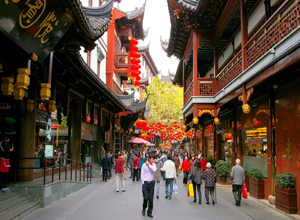
The City God Temple or Chenghuang Miao (Chinese:城隍庙) is a Taoist temple located in the Old City of Shanghai. It connects to the Yuyuan Garden, another landmark of the old city. Today the name of the temple not only refers to the large temple itself, but also the traditional shopping area surrounding the temple. There are over a hundred stores and shops in this area, and most of these store buildings are nearly a century old.
In ancient China, many walled cities contained a temple dedicated to one immortal or god as the spririt of the city. The City God Temple in Shanghai originated as the Jinshan God Temple, dedicated to the spirit of Jinshan (Gold Mountain), an island off the coast of Shanghai. It was converted into a City God Temple in 1403, during the Ming dynasty.In the Qing Dynasty, the temple grew popular. Residents of the old city as well as nearby areas visited the temple to pray for good fortune and peace, which led to many businesses being set up in the area, turning the surrounding streets into a busy marketplace.
The Temple, together with nearby Yuyuan Garden and the surrounding streets, are now part of a large pedestrian shopping zone. It is very a good place to gain the Shanghai food experience.
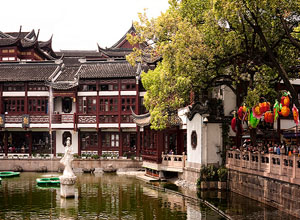
Yu Garden or Yuyuan Garden (Chinese: 豫园) is a famous Suzhou style classical garden in Shanghai and also a must when traveling to the city. It is located beside the City God Temple (Chenghuangmiao) and abuts the Yuyuan Market in the Old City of Shanghai. The garden is accessible from Yuyuan Garden Station of Shanghai Metro Line 10.
Yu Garden was first built in 1559 during the Ming Dynasty by a government officer called Pan Yunduan and was the largest and most prestigious of its era in Shanghai. It passed to different owers after the deline of the Pan family. The gardens suffered damage numerous times during the 19th century, such as by the British Army during the First Opium War, by the Small Swords Society during the Taiping Rebellion, and by the Japanese in 1942. The garden you see today is the result of a five year restoration project which began in 1956 by the Shanghai government. It was open to the public in 1961and declared a national monument in 1982 .
Today, Yu Garden occupies an area of 20,000 square meters (5 acres), and is divided into six general areas: Sansui Hall, Wanhua Chamber, Dianchun Hall, Huijing Hall, Yuhua Hall and the Inner Garden. Each area is separated from the others by “dragon walls” with undulating gray tiled ridges, each terminating in a dragon’s head. A centerpiece is the Exquisite Jade Rock across the Yuhua Hall. The rock is 3.3 meters tall and has 72 holes. There is an interesting thing about the rock. If you pour water into the rock from top, the water will flow out from each hole. Similarly, when you burn a joss stick just below the rock, the smoke will magically float out from all of the holes.
Admission Fee: 40 RMB (Apr.1-Jun.30; Sep.1-Nov.30); 30 Rmb (Jul. 1-Aug.31; Dec.1-the next Mar.31).
Opeinging Hours: 08:30-17:00
















